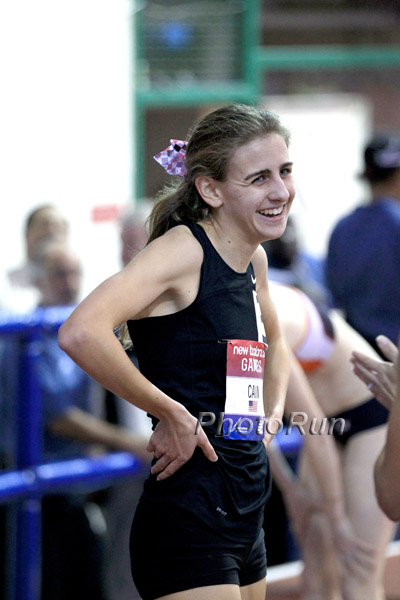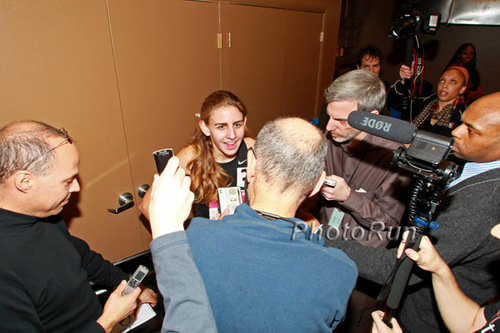
A jubilant Mary Cain after her HSR Mile,
Mary Cain, post mile record, 4:32.78, with media,
The young women above, Mary Cain, made history on Saturday, January 26, 2013. She broke two records, the 1,500 meter high school for American girls, (Lynn Jennings, 1978, 4:18.9), and the high school record for the mile for American girls, (4:38.5h, Debbie Heald, 1972). This was iconic!
Thousands watched the race, thanks to Flo-Track and BU and the Armory. Millions should have been able to watch it. The digital world has given track and field and road running a new life, and helped them reach out to a young audience. Track & Field magazine circulation (Track & Field News, Athletes Only, American Track & Field, Youth Runner) is up, thanks to all of those magazines’s effective websites.
In the London 2012 Olympics, we covered each session LIVE off our curated Live blog site at www.RunBlogRun.com. We had never seen bigger numbers, from our live coverage, and post event follow up on www.runblogrun.com and the RunningNetwork.com. If you present the sport in an interesting fashion, the fans will come.
The point is this though: in 1993, we presented a proposal on a weekly Track & Field show on cable. To this day, still not one on a network like ESPN. Funny thing is, ESPN considered, for many years, track and field broadcasting to be nicely profitable, why, just why is there not a weekly show on the sport?
Saturday, January 26, 2013 was an amazing example of the quality of our sport! Renaud Lavillenie cleared 5.92 meters in Rouen, France, and made serious attempts at six meters in front of 2,500 spectators. In Glasgow, Scotland, Duane Solomon runs 1:15.70 for 600 meters, setting an AR, as Dai Greene and Andrew Osagie dueled for second, with Greene running 1:16.22, for a British record.
Across the pond, Galen Rupp takes seven seconds off his mile PR, running 3:50.92, number two US all time, number five, World all time indoors. Rupp’s splits of 56.7, 1:54.6,2:52.4 showed how close Rupp is to Lagat’s AR.
At the New Balance Games, Mary Cain stayed near the back of the pack, and began to move up after 800 meters, hit in 2:16.7. Cain moved up through the next 400 meters, hit in 3:28.0. Cain runs effortlessly, moving from fifth to third on the penultimate lap.Hitting the bell just over four minutes, Mary Cain hit the 1,500 meters in 4:16.1. Cain’s mark set a new AR, breaking Lynn Jennings’s 1978 record of 4:18.9. Mary Cain was here to break the 4:38.5h of Debbie Heald, set back in 1972, forty-one years ago!
Many saw Rupp’s and Cain’s races on Flo-Track. Flo-Track did a fine job. More should have seen it.
One ponders; why does not Track & Field have a weekly show on ESPN2, with highlights from around the world, a pithy editorial by Toni Reavis,
an interview by Larry Rawson, and a week round up by Ato Boldon? Surely, ESPN has the bucks to purchase content from FloTrack. This seems like a no-brainer.
The FLO-Track covering of both events gave many a chance to see the races. FLO-Track is now charging a subscription to see the events live, and while there seems to much commenting on the subscription charge, readers should consider that quality media costs money-how does one expect FLO-track to cover their costs?
Watching the Rupp mile and then, Mary Cain’s mile, it was apparent how exciting the small, intimate events are, not only to a track geek like myself, but, in my guess, to even the most staunch bball or football fan.
In the next month, on ESPN2, the New Balance Indoor Grand Prix, will be televised on February 3, as will the Millrose Games and the USA Indoor Champs!
We need to look at some creative ways to get races on TV, both terrestrial and cable. This past weekend is just another example of how exciting our sport can be!
Larry Eder has had a 52-year involvement in the sport of athletics. Larry has experienced the sport as an athlete, coach, magazine publisher, and now, journalist and blogger. His first article, on Don Bowden, America's first sub-4 minute miler, was published in RW in 1983. Larry has published several magazines on athletics, from American Athletics to the U.S. version of Spikes magazine. He currently manages the content and marketing development of the RunningNetwork, The Shoe Addicts, and RunBlogRun. Of RunBlogRun, his daily pilgrimage with the sport, Larry says: "I have to admit, I love traveling to far away meets, writing about the sport I love, and the athletes I respect, for my readers at runblogrun.com, the most of anything I have ever done, except, maybe running itself." Also does some updates for BBC Sports at key events, which he truly enjoys. Theme song: Greg Allman, " I'm no Angel."
View all posts






















As a Television Producer, I have found, the easiest way to produce a Track and Field show is to produce it independently and give the show to a local sports network, like SNY, YES Network etc… and carry your own sponsorship/commercials on the program and give the cable network a few spots as well.
ESPN has no incentive to devote production money to the sport at this point due to lack of popularity. This is how those Fly Fishing and Fitness shows get produced and aired. It’s essentially first run syndication, but you don’t sell the show to a network, you barter the advertising. This is the only way it can done until you can prove you can get ratings. Then you can rerun the show on the internet afterwards.
This is what Flotrack should do.